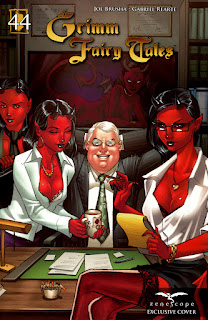GFT Retrospective #48: The Devil's Brother
Article by Sean Wilkinson,
a.k.a. the Parrot's Greasy Brother
I have a parrot and I fry chicken at a deli. I also occasionally feed my parrot-brother pieces of chicken and he doesn't seem to mind because chicken is delicious. I'm sure there's a Lilo & Stitch meme I could reference here, but Blogger only shows the first image or video in a post and I want the issue cover to get the feature, so use your favorite search engine to figure out why I'm an abomination instead. Also, that's my tie-in between the a.k.a. and the Zenescope issue up for review today. I hate the focus character, but there's a lot to say about the issue and its fairy tale sources, so please remember to like and comment down below, subscribe to my blog, and follow me on Tumblr, Reddit, and Facebook for the latest news on my content, which we'll get into starting now.
GFT #44: The Devil’s Brother
Fenton sucks. He’s the least likeable secondary villain character since Charles Dodgson. He exists in the Grimm Universe for the sole purpose of looking, sounding, feeling, acting, and generally being the embodiment of every gerunded verb that could possibly have the word “disgusting” after it. That said, it’s only “fair” that in a series--and a medium at large--that is known for objectifying the freezer-bait population of its character base, the fat, cowardly pervert gets his own origin story?So, it turns out that Fenton was a soldier in the American Civil War prior to taking Sela and Belinda to a strip club, playing Stratego with Satan, and ordering goblins to murder an endangered, magical horse on its birthday. Wow. He really…moved up?…in the world. While delivering “the sword”--presumably the sword forged from the dead unicorn that Orcus mentioned in The Gift short story--to “someone we have watched for a long time,” Fenton has flashbacks to the day he first met Death and the Dark One. After his childhood friend brow-beats a half-hearted confession of loyalty out of him and then abandons him to be murdered by Confederate soldiers (because apparently not even long-standing friendship and the spirit of Army brotherhood are strong enough to make Fenton likeable), he makes the old “I’ll do anything!” mistake and ends up at the beck and call of the Dark One. But because this is Grimm Fairy Tales, there has to be a fairy tale attached.
The fairy tale, told in an abridged format here by the series Devil himself, is a Brothers’ Grimm selection titled “The Devil’s Sooty Brother.” The original is one of several versions included in the brothers’ Kinder Und Hausmarchen publications, each of which has some variation on the following plot: A poor or abandoned soldier (sometimes a trio of soldiers) encounter a Rumpelstiltskin-ish man who identifies himself as the Devil and promises the unfortunate protagonist(s) that they will have all that they require to live, so long as they serve him in Hell for seven years. There is usually a temptation or limitation presented to them by the Devil, such as not interacting with the damned souls that they are tasked with watching over in the Devil’s absence, not grooming themselves for the duration of their servitude, or only agreeing to speak certain words in a certain order regardless of the consequences. In nearly all of the stories, the main character(s) are true to the agreement and end up with great wealth, power, and/or love. On the surface, these might seem like unsavory, pro-Satanic parables to the effect of “serve the Devil, get rich,” but I think the purpose behind them is much more profound and beneficial; that these stories are not about serving the Devil, but about being true to your word and resisting temptation and sin. For example, in agreeing not to bathe or shave themselves, the protagonists are resisting their impulses toward vanity and pride. In the case of the three soldiers who must only speak certain words, in following the Devil’s instructions, they are almost hung for thievery and murder before aiding in the capture of the real culprit, which serves as sort of a test of faith for the trio. Even in the case of the original “The Devil’s Sooty Brother,” wherein the soldier gives in to curiosity, as well as thoughts of vengeance and mercy towards the souls he finds in the Devil’s furnace, serves to show its audience the consequences of un-Christian living. The soldier is still rewarded in the end, but to have the wealth and power he needs, he must sacrifice his identity and is cursed with a life of loneliness, devoid of the truly full experience of living.
In service of the Grimm Fairy Tales plot, however, the Dark One’s abridged version takes the shallower, more literal approach to interpretation, and involves Fenton orchestrating a mass killing of Cheyenne natives (perhaps ancestors of the child with the dreamcatcher?) and burning his childhood friend to death in exchange for wealth and immortality--more “souls for awesomeness” nonsense. We find out that the Dark One’s other henchman--the huge, dreadlocked man from the Vegas Annual--is Volac, a legionnaire the Dark One recruited through the course of his telling of the fairy tale.
A nice bit of depth to an otherwise depthless presentation of an unlikable goon’s rise to fleeting power.
Next week, we finally get to see why the Monroe name has been getting so much hype lately.
Another sarcastic yay.
Ticketmaster,
Out.




Comments
Post a Comment